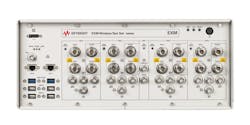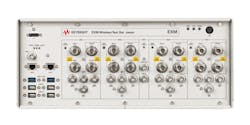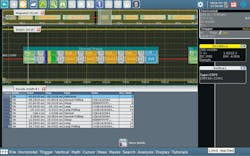Cars are evolving into mobile data centers, as described in our recent special report on the topic.1 Industry experts representing Anritsu, Keysight Technologies, Pico Technology, Tektronix, and Teledyne LeCroy have elaborated on their approaches to testing connected-car technologies including IEEE 802.11p as well as LIN, CAN, CAN FD, FlexRay, MOST, and BroadR-Reach buses. And Rohde & Schwarz has expanded the functionality of its oscilloscopes to include a triggering and decoding option for the new CXPI protocol.
Jungik Suh, marketing program manager, Automotive and Energy Solutions, Keysight Technologies, provided extensive information on Keysight’s approach to 802.11p in an EE web exclusive article.2 For 802.11p design and test, he said, Keysight offers the SystemVue, the Advanced Design System, and the GoldenGate software platforms. In addition, he said, the company offers signal-analysis and signal-generation solutions such as the E6640A EXM wireless test set (Figure 1)—a one-box tester optimized for multidevice testing with up to four transmit/receive units loaded into a PXI mainframe.
Courtesy of Keysight Technologies
Craig Hendricks, senior technologist, Automotive Focus Team, Anritsu, said, “Anritsu provides a variety of instruments for automotive test applications”—particularly involving wireless technologies. Those instruments can be used in the design, development, and manufacturing stages, he said, adding, “The MD8475A/MD8475B, as well as the Site Master, BTS Master, Spectrum Master, and VNA Master handheld analyzers, can all be used to troubleshoot field issues.”
He continued, “The MD8475A signaling tester has options for testing the eCall and ERA-GLONASS systems for emergency roadside assistance in Europe and Russia. The MS2830A and MS2690 Series signal analyzers have options for RF testing and protocol decode of the DSRC V2X systems for the United States, Japan, and Europe.”
Hendricks also said automakers, their suppliers, cellular carriers, and cellular chipset providers employ the MD8475A. “It is known for being particularly easy to use and set up tests without the need for complex scripting as in many other products on the market,” he said.
He concluded by saying the new MD8475B cellular device RF tester (introduced in June) supports LTE-Advanced carrier aggregation up to 4CC or four component carriers with a single instrument. “It provides similar test advantages to automotive designers as the MT8821C,” he said. “It also can support up to 4CC with 2×2 MIMO. The U.S. cellular network operators currently support 2CC carrier aggregation and 2×2 MIMO but within the next year will support 3CC and maybe 4CC and up to 4×4 MIMO.”
Protocol triggering and decoding
Robert Mart, product manager at Teledyne LeCroy, focused on his company’s support for CAN/CAN FD, FlexRay, MOST, and BroadR-Reach protocols and triggering and decoding capabilities of the company’s oscilloscopes. “Most serial triggers work with digital inputs or the EXT input for the clock line to save analog channels for signal lines,” he said. “Each serial trigger provides features peculiar to a given protocol to deliver the highest possible performance. For example, the CAN, CAN FD, and FlexRay triggers permit conditional ID/address triggering.
As for serial decode, Mart said, “Our color-coded transparent overlays make it easy to distinguish between various portions of each protocol. Unlike competitive solutions, the decoded information and waveform are correlated directly on the display rather than the decoded data being in one area of the display and the waveform in a separate area. The decode overlay will automatically adjust to longer or shorter acquisitions to show you just what you need to know. All decoders let you search through long records using a variety of criteria or data values. ‘Pattern Search’ automatically creates a zoom trace of the waveform and displays the selected location. Meanwhile, an interactive table summarizes results. Touch a message in the table and you’ll automatically get a zoom trace of it.”
Teledyne LeCroy also offers measurement and graphing capabilities. “Automated timing measurements let you use a serial trigger to isolate a specific message and then measure a cause-effect timing relationship with a subsequent analog signal or vice-versa,” Mart said. “Options include comparing a serial message to an analog signal, analog signal to serial message, or serial message to serial message. Also, digital data can be extracted from specific locations in the serial stream using the ‘Message to Value’ measurement parameter as though it had been probed directly, effectively acting as a serial-data DAC.” Also available are bus status measurements, automatic generation of statistical data and histograms, and conditional filtering. Finally, the company offers eye-diagram capabilities with which eye diagrams can be combined with masks and mask-failure indicators.
Chris Martinez, strategic planning manager at Tektronix, elaborated on his company’s offerings, saying, “Products are used extensively in the development phase, including characterization, debug, and compliance.” They find use across the automotive ecosystem starting with the silicon providers and moving on to tier I/tier II device (for example, ECU) manufacturers, and on to the OEMs for system-level development and integration. In addition, he said, Tektronix products are used by test houses as a part of system and compliance testing.
Commenting specifically on wireless test, Martinez said, “The challenges range from implementation of common wireless standards like Wi-Fi, Bluetooth, and LTE into a harsher environment that is more prone to EMI and other RF interferences. The Tektronix RF portfolio helps customers by offering support for RF-specific technologies (for example, Wi-Fi) but also can address mixed-domain applications that may require analysis of both time and frequency domains. In-vehicle testing is addressed by our ultra-portable USB spectrum analyzer (RSA306B).”
As for buses, he added, “The Tektronix MDO4000 mixed-domain oscilloscopes give customers the ability to synchronize analog, digital, and RF signal analysis at the same time in a single product along with the six-in-one functionality that includes protocol support for FLexRay, CAN, and LIN, among others.”
Data sharing
Trevor Smith, business development manager at Pico Technology, commented on the capability to share data throughout the automotive ecosystem. “Key with PicoScope products is the fact that data generated anywhere, at any stage of the lifecycle, and in any country, can be viewed and analyzed using the free PicoScope 6 software by any engineers in their own language,” he said. “With normal file transfer or remote desktop applications, the engineering and regional support teams can see what is happening to any vehicle wherever it is—all without leaving their desks. Although workshop technicians may not understand the detail of a CAN or FlexRay message, their ability to capture the signals and make those available to engineers running the same software provides engineering insight into obscure problems at the point where they are occurring in the field.”
Smith added, “PicoScope users can create their own applications using the supplied software development kit. One such application, a frequency response analyzer (FRA), has been widely shared on the Pico Forum. The FRA can be used to make Bode plots to perform gain and phase margin analysis of filters, operational amplifiers, and control loop response. Engineers producing control systems for power management, driver assist, and fly-by-wire systems use the FRA to validate correct operation within acceptable margins over the full specified operating range.”
CXPI protocol test
And finally, Rohde & Schwarz has expanded the functionality of its R&S RTE and R&S RTO digital oscilloscopes to include a triggering and decoding option for the new clock extension peripheral interface (CXPI). This newly developed automotive bus is a cost-effective alternative to the LIN protocol. CXPI was standardized in 2015 under SAE J3076 as a communications bus for diverse automotive applications. The bus uses pulse-width modulation to transmit data over a single wire at 20 kb/s. The characters used are based on UART.
With the new R&S RTx-K76 CXPI option, you can use the RTE and RTO scopes to decode protocol details and isolate anomalies by triggering on the corresponding details. When debugging CXPI interfaces during development, you can trigger on conditions such as start of frame, frame ID, data values, and various error conditions. The instruments’ search and navigation functions make it easy to detect relevant events in the CXPI data stream. The oscilloscopes can display decoded telegrams as color-coded bus signals in a waveform diagram or as a table (Figure 2). As a result, developers can verify the quality of their products early during development.
Courtesy of Rohde & Schwarz
The R&S RTE and R&S RTO let users simultaneously decode up to four serial buses from analog or logic signals. The oscilloscopes also deliver fast eye-diagram mask tests using the standard mask test functionality.
References
- Nelson, R., “Vehicle communications drive test challenges,”
EE-Evaluation Engineering, October 2016, p. 8. - Nelson, R., “Software plus signal generators and analyzers support IEEE 802.11p design and test,” EE-Evaluation Engineering Web Exclusive, Oct. 5, 2016.
About the Author

Rick Nelson
Contributing Editor
Rick is currently Contributing Technical Editor. He was Executive Editor for EE in 2011-2018. Previously he served on several publications, including EDN and Vision Systems Design, and has received awards for signed editorials from the American Society of Business Publication Editors. He began as a design engineer at General Electric and Litton Industries and earned a BSEE degree from Penn State.


